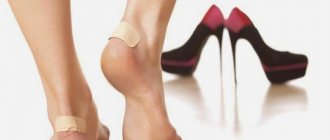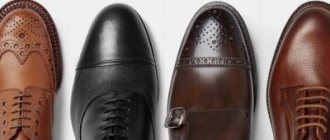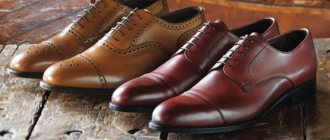A situation familiar to many: shoes that fit perfectly on the foot when purchased, on the very first day rub, pinch and cause discomfort. But don’t despair: today there are many effective ways to stretch leather shoes at home.
Genuine leather is a fairly soft and elastic material. It’s not difficult to stretch leather shoes using affordable home remedies.
We have prepared for you an overview of simple and accessible methods that everyone can master.
Army way
An effective and perhaps the easiest method to stretch leather shoes.
Take thick cotton or wool socks, soak them in hot water and wring them out to remove excess moisture. Put on a pair of shoes that need stretching and walk around the house until your socks are dry (or until you get tired of it). After this, dry the shoes using paper or newspapers. Ready. The skin will stretch under the influence of moisture, take the shape of the foot, and the shoes will no longer press.
In the army, according to rumors, this method is used somewhat differently - in socks and tight shoes they stand directly under a hot shower. But this is an extreme option for tough men
How not to damage?
Using products such as vinegar or alcohol can ruin your shoes. Poorly dyed shoes may fade. Therefore, before applying the product to the entire surface, experiment on a small area . In addition, frozen water (stretching in the freezer) can damage the natural material. To prevent this from happening, leave the shoes until the ice melts and only then remove the bags from them.
What are trekking boots
What to wear with gray women's boots
Freezing
To stretch leather shoes wider, you don’t have to wear them in for a long time and endure pain. You can use a more gentle method.
Take two strong plastic bags, place them inside the shoes and carefully pour water to fill the entire interior space from toe to heel. Tie the bags tightly to prevent water from escaping and place the shoes in the freezer. Leave to freeze for 6-8 hours.
As the water hardens, it expands and stretches the skin. After the time has passed, remove the shoes from the freezer, let the ice thaw a little and carefully remove the bags. Do not try to remove the ice immediately - you may scratch or tear your shoes.
The freezing procedure can be repeated if the skin is not stretched enough the first time
Hot way
There are two options for stretching shoes using a hot method: using a hairdryer and boiling water.
To stretch leather shoes with a hairdryer, put on thick socks, put your shoes on and squeeze your feet, as if stretching the shoes from the inside. Turn on the hairdryer and direct warm air streams to those areas where your shoes are pinching you. Do not bring the hair dryer too close to the skin and try not to direct hot air onto the taped seams. After completing the procedure, walk around in your shoes until they cool down.
After blow-drying, lubricate your shoes with a special cream to restore the balance of lost moisture. If there are no professional products, you can use regular hand cream or Vaseline
When stretching your shoes with a hairdryer, do not overdo it: you can dry out the leather and achieve the exact opposite effect.
An effective way to stretch leather shoes is to use boiling water. Before you begin stretching, be sure to remove the insoles from your shoes. Under the influence of boiling water, the insoles are greatly deformed, lose their appearance and begin to cause discomfort when walking.
Boil water, place the shoes over a container and carefully pour boiling water inside. Leave to act for just a few seconds and pour out the water. Blot the moisture, wait a couple of minutes for the shoes to cool slightly, and put them on, after putting on thick socks. Walk around in your shoes until they are completely cool. The hot water will soften the skin and as it cools it will mold to the shape of your foot. This method will help stretch leather shoes to fit.
If you are afraid of damaging the inner surface of the shoe, you can place a bag inside to create a cushion between the boiling water and the material
Do not use boiling water to stretch artificial leather shoes - only natural material will withstand exposure to temperature and moisture.
What to remember
When using traditional methods of stretching leather shoes, be careful and strictly follow the recommendations to avoid aggressive effects on the material. Before stretching with special means, be sure to check whether the method is suitable for your type of shoe. Contact a shoemaker if you are unable to stretch your shoes using any of the methods. And if you accidentally put a stain on your favorite shoes, it can be easily fixed by professional cleaning - we use German environmentally friendly chemicals that carefully and effectively remove any stains.
Alcohol
Soak the inner surface of the shoes with an alcohol solution (water and alcohol 1:1) or vodka. For convenience, you can use a spray bottle. Wear thick socks and walk around in your shoes for about an hour. The pungent odor after the procedure can be eliminated with a soap solution (or simply leave the shoes in the air). Alcohol dries out the skin; After stretching, lubricate your shoes with special cream or Vaseline.
The alcohol solution can be replaced with an alcohol-based window cleaner or cologne.
Use alcohol-containing liquids carefully on colored shoes. Pre-test the paint for durability by treating an inconspicuous area of skin with alcohol.
Breaking in a new pair
Having happily brought home your purchase, you may regret to notice that the new thing is too tight. It’s better to take it back, if it’s a pity to part with the desired item of clothing, you should try to stretch it. Autumn shoes or ankle boots cannot be enlarged if they:
- two sizes smaller;
- press under the edging;
- made from some types of leather substitutes.
Natural coating, it is recommended to stretch it with alcohol-containing liquids. You should wet thin socks, put them on and walk actively in your shoes for 40 minutes. It is advisable to buy a special product rather than experiment.
Oils
Leather shoes made from both natural and artificial materials can be stretched using oils. Castor or other vegetable oil, as well as Vaseline (can be replaced with fatty cream), are suitable for this purpose.
Remove the insoles from the shoes, lubricate the areas where the shoes are pinching with oil or Vaseline (you can treat both the inner and outer surfaces), and leave for several hours. After this, thoroughly wipe your shoes, put on thick socks, put on your shoes and walk around the house. The oil softens the skin, it becomes more pliable and stretches to fit the shape of your leg.
The oil will help stretch not only new shoes, but also tidy up a rough pair of shoes that you haven’t worn for a long time.
Lubricate the areas where the shoes feel tight with oil. Let the boots sit for several hours. Then thoroughly wipe your shoes, put on thick socks, put on your shoes and walk around the house
Choosing the right dress shoes
When choosing a new pair, use a few simple tips:
- Make purchases in the late afternoon when your foot size is at its maximum;
- The feeling of the toes when trying on should come first, as you need to feel a certain freedom;
- It is necessary to monitor the fullness indicated by the manufacturer, since each of them is guided by its own size;
- When buying products for every day, choose a low heel from three to five centimeters.
Trying on both boots and shoes, as well as sandals, is necessary on two feet at the same time to determine that they are the same size.
It's worth walking on the floor a little to evaluate how comfortable the pad is for you. It is recommended to wear models of various types, only in this case the foot will not get used to only one type of last.
You should be especially careful when choosing shoe models for children. A child’s foot and boot are just beginning to form, so the wrong choice of shoes, even for one season, can lead to musculoskeletal problems later in life.
Traditional methods
Vinegar is often used to soften and stretch leather shoes . The smell, of course, is unpleasant, but it disappears quite quickly in the fresh air.
Moisten the inside of your shoes with table vinegar (3-9%) in the places where they feel tight, put on thick socks and walk around the house for about an hour. The pungent odor from vinegar can be eliminated with a soap solution (or by airing out your shoes).
Use vinegar with caution on colored shoes. Pre-test the paint for durability on an inconspicuous area of the skin.
To stretch thin leather or delicate suede, you can use beer . The technology is the same: saturate the shoes from the inside, put on thick socks, put on your shoes and walk around for a couple of hours. To get rid of beer smell, air your shoes in the fresh air.
One of the most common ways to stretch leather shoes is to fill them with wet newspapers .
Newspapers or sheets of paper are cut into very small pieces, tightly stuffed into leather shoes and filled with water. The paper swells from moisture and tightly fills the internal space. The shoes and paper are dried naturally away from heating devices (about 2 days). This method is time-tested, but it is not recommended for light shoes - it is more suitable for shoes or boots.
How to stretch shoes made of fabric, nubuck, suede and fur
None of the previous methods (except for wearing them on the toe) should be used for shoes made of nubuck or any other natural materials. Alcohol is not suitable for the reason that “drunk” shoes will stain, and after drying they may crack, and oils will leave greasy stains on the fabric and suede. Boiling water is too aggressive, cryotherapy will completely “kill” the shape of dress shoes... But remember - there is always a way out!
Method 1 – professional remedy
The easiest way to stretch suede or nubuck shoes is to purchase a special spray at the supermarket. For example, stretching agent from Salamander, Oke, Twist, Salton, Kiwi, Silver. Just ask your consultant how, besides the price, one jar differs from another. Perhaps a more expensive product also provides a water-repellent effect, or is safer for shoes and feet.
Method 2 - using newspaper
A more complex way to stretch shoes made of delicate materials is to use “yellow press”. Crumple up enough newspaper, stuff it inside your uncomfortable shoes, and leave it overnight. The paper will straighten slightly and thereby adjust the width of the shoe.
People's advice suggests moistening newspapers with alcohol or even plain water. We strongly do not recommend doing this: there is a high probability that the printing ink will be imprinted on the walls of the shoes or sandals.
Keep in mind: it is almost impossible to stretch shoes with fur. The best solution would be to wear it around the house with warm socks and periodically warm it up with a hairdryer. You can also replace the original insole with a thinner one from the store. This will make your foot more vulnerable to cold weather, but will allow you to wear the shoes you like without pain.
Cowboy way
In the Wild West, grain was used to stretch leather boots. They filled shoes with it, filled it with water and left it overnight. The grain absorbed water, swelled and stretched the skin. In the morning, the shoes were freed from the filling, wiped and worn until dry.
This method has the right to exist today. However, it cannot be used for lined shoes
Modern chemistry
Today, on store shelves there is a decent selection of special means for stretching shoes: foams, sprays and aerosols. From a rich assortment you can choose the option that suits your pocket. How to use the chosen product, read the manufacturer's instructions.
For expensive shoes made of thin leather, it is better to use modern foams or stretching sprays - all other methods can damage the delicate material and ruin your shoes
Mechanical stretch
Today it is not difficult to buy a special mechanical stretcher in a shoe store. It is a wooden (or plastic) block, which is equipped with a screw mechanism for forceful expansion. The kit, as a rule, contains a spray and special pads of various shapes that will help stretch the shoes in certain areas (if there is a bone, crooked fingers, calluses and other orthopedic indications).
A mechanical shoe stretcher can be purchased for home use. Its cost is relatively low, and its effectiveness is obvious
Professional approach
If finances allow, then you can use the services of professionals - this is the fastest and most effective way to get rid of problems with new shoes.
By the way, there is an opinion that it is impossible to stretch leather shoes in length. In general, this fact cannot be refuted, but today professionals can offer a solution to this problem. As a rule, the leather at the toe of the shoe is thicker, and thanks to the combined effects of mechanical stretching, spray, special attachments and electrical heating, this area of leather can be stretched to give more room to the toes.
Check the availability of shoe stretching services in workshops in your city
Getting rid of chafing
Any shoes can rub the skin, even those that have already been worn in, but have not been used for a long time. But friction occurs especially often in open summer shoes.
To prevent unpleasant calluses from forming on the skin, which can quickly turn into bloody wounds, it is better to use modern anti-chafing agents from the first days of wearing the products:
- Sticks for calluses . They are made on a solid fat base and are designed to treat the skin in problem areas and areas that are likely to chafe. The products reduce skin friction on the material and leave no marks.
- Special stripes . They are made on an adhesive basis - the device is glued to those places that can be pressed and rubbed. They effectively protect the skin and cope with the problem of chafing.
- Gel pads or heel pads . The transparent, ultra-thin devices are glued to the inside of the shoe, making them invisible. The product secures the foot in the shoe, prevents slipping and makes the gait more confident. Heel guards are especially relevant for lovers of high-heeled shoes and sandals.
- Callus patch . It is used when trouble has already occurred and a callus has formed on the skin. It is best to use an antibacterial patch based on salicylic acid. It has softening and antibacterial properties and prevents the appearance of suppuration.
What to do to prevent new shoes from rubbing calluses is described in the video:
If all of the above methods of stretching shoes did not help, most likely the model will no longer be able to be increased in length and width.
Therefore, it is recommended that even at the time of purchase, you carefully study the item you like and do not buy shoes that are too tight in the hope that over time they will “break apart” on your feet.
Useful tips
In conclusion, some more useful tips:
- buy shoes in the afternoon, when your feet are slightly swollen, to avoid problems with the size later;
- do not put on new shoes for the whole day at once, break them in gradually;
- Cover frequently rubbed areas with adhesive tape in advance. This will avoid the appearance of calluses;
- if the back of the shoes rubs, lubricate it with paraffin or soap;
- Buy shoes for important events in advance, keep in mind that you will need time to stretch. Read about how to quickly break in new shoes in our other article.
If you have already tried the methods listed above or have your own method of stretching shoes, share your experience and tips with us in the comments.
Is it possible to quickly break in shoes made of genuine leather?
Genuine leather is good because it does not become rough and wears out quickly. If the shoes are a little tight, then you can break them in yourself without using any improvised means and without contacting a specialist .
To prevent your shoes from chafing, it is better to wear them in at home with thick socks on your feet. This will save you from blisters. However, stretching natural material into several sizes will not work. Firstly, thin skin can burst. Secondly, it may stretch unevenly, as a result the shoes can only be thrown away.











